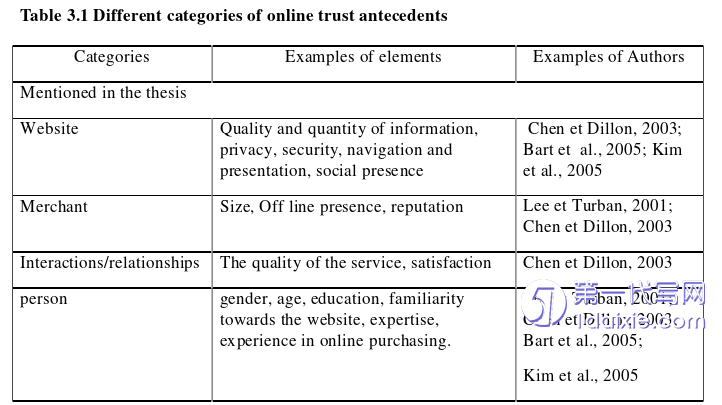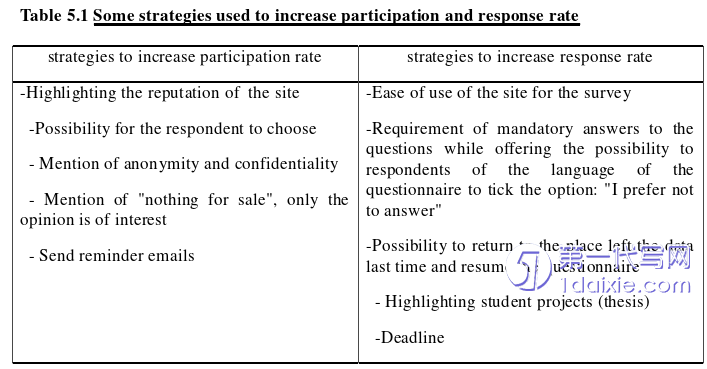本文是一篇电子商务论文,笔者认为尽管存在局限性,但这项研究的数据非常重要,丰富和改进了我们对摩洛哥互联网用户信任决定因素的分析。在确认这些假设后,我们的愿景的自然延伸可以面向与邻国进行比较研究。
CHAPTER ONE: INTRODUCTION
1.1. BACKGROUND AND SIGNIFICANCE OF THE STUDY
Notwithstanding the many studies that have dealt with trust, it remains a concept that arouses the interest of many researchers from different disciplines such as psychology, sociology, marketing and e-commerce. Several definitions have been proposed (Lewicki, McAlliter and Bies, 1998; Urban, Amyx and Lorenzon, 2009). It is sometimes considered as a presumption, an expectation or a belief but also as a behavioral intention or behavior (Guibert, 1999; Chouk and Perrien, 2005; Toufaily et al., 2010).

Its complexity, characterized by varied definitions but also by confusion at the level of the antecedents and dimensions associated with it, makes it an interesting field of research (Grabner-Krauter and Kaluscha, 2003; Angriawan and Thakur, 2008). For example, in an online context, some authors have considered perceived risk as a facet of trust (eg Mukherjee and Nath, 2003; Kassim and Abdulla, 2006) and not as an antecedent or a moderating variable. Apart from the complexity of trust, the emergence of the Internet as a new means of commercial, transactional and communicational exchange has given it an essential character (Urban, Amyx and Lorenzo, 2009); trust would be more important in an online context than offline (Bailey and Bakos, 1997; Ratnasingham, 1998; Hoffman, Novak and Peralta, 1999; Harris and Goode, 2004). Indeed, the little or even absence of human contact combined with the intangibility of products/services, fears relating to security, hacking and illicit intrusion into customer databases, accentuate the importance of online trust (Chouk and Penien, 2005; Beldad, de Jong and Steehouder, 2010).
1.2. RESEARCH QUESTIONS AND OBJECTIVES
Apart from the importance of online trust, knowing the antecedents of this trust is essential for both researchers and professionals (Jarvenpaa, Tractinsky and Vitale, 2000; Bartikowski, Chandon and Muller, 2008). However, if the studies have often taken into account some elements of antecedents, rare are those which have analyzed the different consequences of online trust (eg Yoon, 2002; Grabner-Kraüter and Faullant, 2008). Thus, the present work, which aims to be integrative, differs from the previous ones insofar as the essential antecedents of online trust are simultaneously taken into account with the main consequences of this trust.
In this perspective, the e-commerce is chosen as a field of empirical validation. In fact, the majority of the population does business with a financial institution and consumers are increasingly carrying out their financial transactions online (Colgate, Buchanan-Oliver and Elmsly, 2005). However, the complexity and intangibility of financial services as well as the high levels of involvement required (Delvin, 2000), associated with the reduction of human contact and the perceived risk on the Internet (Beldad, de Jong and Steehouder, 2010), make online trust play an important role in this industry. For some consumers, lack of trust is considered one of the main reasons why consumers are reluctant to carry out their financial transactions online (Flavian, Guinalîu and Gurrea, 2006; Grabner-Kraüter and Faullant, 2008). Regarding studies that have dealt with the antecedents and consequences of trust in this sector, such studies are either conceptual (e.g. Yousafzai, Pallister and Foxall, 2003) or only deal with two or three antecedents (e.g.: Kassim and Abdula, 2006). Furthermore, the consequences of online trust seem insufficiently examined; for example, Yoon (2002) considered only purchase intentions as consequences.
CHAPTER TWO: LITERATURE REVIEW
2.1. TRUST: A GENERAL CONCEPT
Some authors who have synthesized trust in both a traditional context (e.g. Rousseau et aL, 1998; Guibert, 1999) and online (e.g. Bart et aL, 2005; Chouk, 2005b), stipulate that it is a complex concept, insofar as it is difficult to propose a definition due to a plurality of dimensions to be taken into consideration (Wang and Emurian, 2005). Indeed, not only is trust difficult to observe and measure directly (Kim et al., 2005), but it has several facets: cognitive, emotional or affective and behavioral (Lewis and Weigert, 1985; McAllister, 1995). The cognitive facet focuses on rational foundations such as the characteristics of the merchant, namely competence, reliability, etc. Trust based on cognition or knowledge (Chopra and Wallace, 2003) and technical trust (McAllister, 1995) are all terms used to identify this first facet.
The affective facet, for its part, includes different forms of trust such as emotional trust (Graf et al., 1999), trust based on affect or on identification, relational trust, interpersonal trust (Chopra and Wallace , 2003) and moral trust (McAllister, 1995). This facet is often materialized by benevolence (Johnson and Grayson, 2005).
Finally, the behavioral facet translates into confident behaviors (Chouk and Perrien, 2005). A distinction is made between behavioral intention (Moorman, Zaltman and Desphande, 1992; McAllister, 1995) and behavior action (Deutsch, 1960) which are part of trust (Chouk and Perrien, 2005). Behavioral intention corresponds to a desire or intention to commit to a trusting relationship according to McKnight, Choudhury and Kacmar (2002). According to them, an individual is ready to commit, to depend on the other, without to be able to control the other.
2.2. ONLINE TRUS
In the late 90s and early 2000s, studies on online trust emerged. They come mainly from work in electronic commerce (Lee and Turban, 2001; Corbitt, Thanasankit and Yi, 2003; Pavlou, 2003), in management (Stewart, 2003; Gefen and Straub, 2004), in information systems (Bhattachejee, 2002; McKnight, Choudhury, Kacmar, 2002) and in marketing (Bart et al., 2005).
Previous studies have also reviewed the impact of trust on disruptive models and platforms used in electronic markets. As an illustration, in a study conducted by Hawlitschek et al. (2018) in the context of sharing economy, trust was categorized into "trust in peers" and "trust in the platform".
In an online context, several types of trust can be distinguished, including trust in the Internet (Grabner-Kraüter and Faullant, 2008), trust in buying/selling online (Lee and Turban, 2001; Cheung and Lee, 2006), trust in Internet banking (Kassim and Abdulla, 2006), trust in the site (Allagui and Temessek, 2005; Bart et al., 2005; Chen, 2006; Flavian, Guinaliu and Gurrea, 2006 ) and trust in the online merchant (Bhattachejee, 2002; Gefen, Karahanna and Starub, 2003; Pavlou, 2003; Harris and Goode, 2004; Eastlick, Lotz and Warrington, 2006; Schlosser, White and Lloyd, 2006). This typology of online trust makes its study more difficult.
Like the literature related to offline trust, that of online trust is also nebulous as to a clear definition and the dimensions that compose it. It is therefore important, thanks to this second chapter, to make an overview and to bring certain clarifications.
CHAPTER THREE: ANTECEDENTS OF ONLINE TRUST AND MODERATING VARIABLES ..... 15
3.1. WEBSITE FEATURES ................................... 17
3.1.1. INFORMATION QUALITY ................................ 17
3.1.2. EASE OF NAVIGATION .............................. 17
CHAPTER FOUR: OVERVIEW OF E-COMMERCE IN MOROCCO ................................. 32
4.1. The main players in the e-commerce market: ................................. 35
4.1.1. Electronic commerce operators ............................... 35
4.1.2. Banks ..................................... 36
CHAPTER FIVE: METHODOLOGY AND RESULTS ........................ 41
5.1. Methodology .................................... 41
5.1.1. Choice of quantitative research .............................. 41
5.1.2. Sampling plan..................... 42
CHAPTER FIVE: METHODOLOGY AND RESULTS
5.1. Methodology
This section aims to describe the methodology chosen in order to meet the research objectives set and to test the hypotheses. It should be noted that this study seeks to determine the antecedents of trust in e-commerce. First, the context of the research will be described. Secondly, the choice of quantitative research will be justified. Next, the sampling plan and method of data collection will be discussed. The description of the steps leading to the final questionnaire as well as the presentation of measures will be outlined. Finally, the presentation of data processing will close this chapter.
5.1.1. Choice of quantitative research
This thesis aims to study the antecedents of online trust in Morocco. Depending on the objective, descriptive research is appropriate. The cross-sectional study is preferred because it is a methodological approach that agrees with what is found in the literature relevant to the study of online trust. In other words, it's a snapshot study that aims to get specific information (have a picture of a market) at a specific time. More specifically, the thesis deals with trust as a psychological state evaluated at a time and not as a process (according to the development phases of the relationship) requiring a longitudinal study (eg: Kim, Ferrin and Rao, 2009).

CHAPTER SIX: CONCLUSION, RECOMMENDATION AND FUTURE RESEARCH
6.1. Achieved remarks
The arrival of the Internet and the change in its role as a transaction medium have created a new dimension: that of trust in virtual commerce. The various dimensions influence each other.
Through this research, we aim to identify the determinants of trust while reviewing its different meanings. Several research works (Dwyer and Lagace, 1986, Smith and Barclay, 1997, Chouk and Perrien, 2005) refer the apprehension of the concept of trust to two variables: psychological variables, where trust means expectation, belief or presumption and behavioral variables into an intention of will and behavior.
Some research admits the dichotomy between the two approaches; others discern that a boundary delineation between the two approaches is difficult to achieve. Trust is approached as a psychological state preceding behavioral intention. The latter is a consequence of trust and does not fit into its conceptualization (Morgan and Hunt, 1994). It exists through the combination of belief and will to arrive at a two-sided construct for the conceptualization of it (Smith and Barclay, 1997).
In the context of our research, consumer confidence in virtual commerce can be defined as "the consumer's beliefs and presumptions that electronic transactions will take place with respect for the commitments announced on the part of the other party of the exchange without any opportunism on his part".
reference(omitted)
